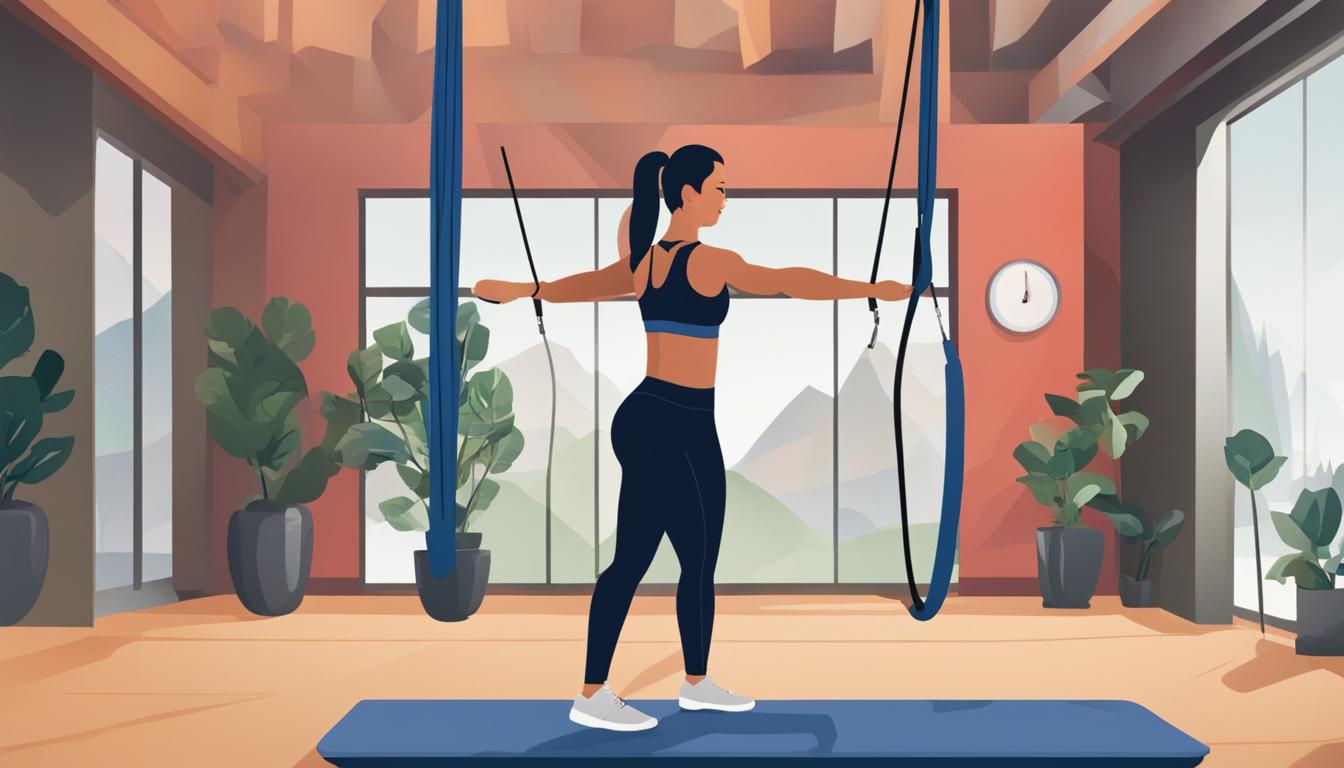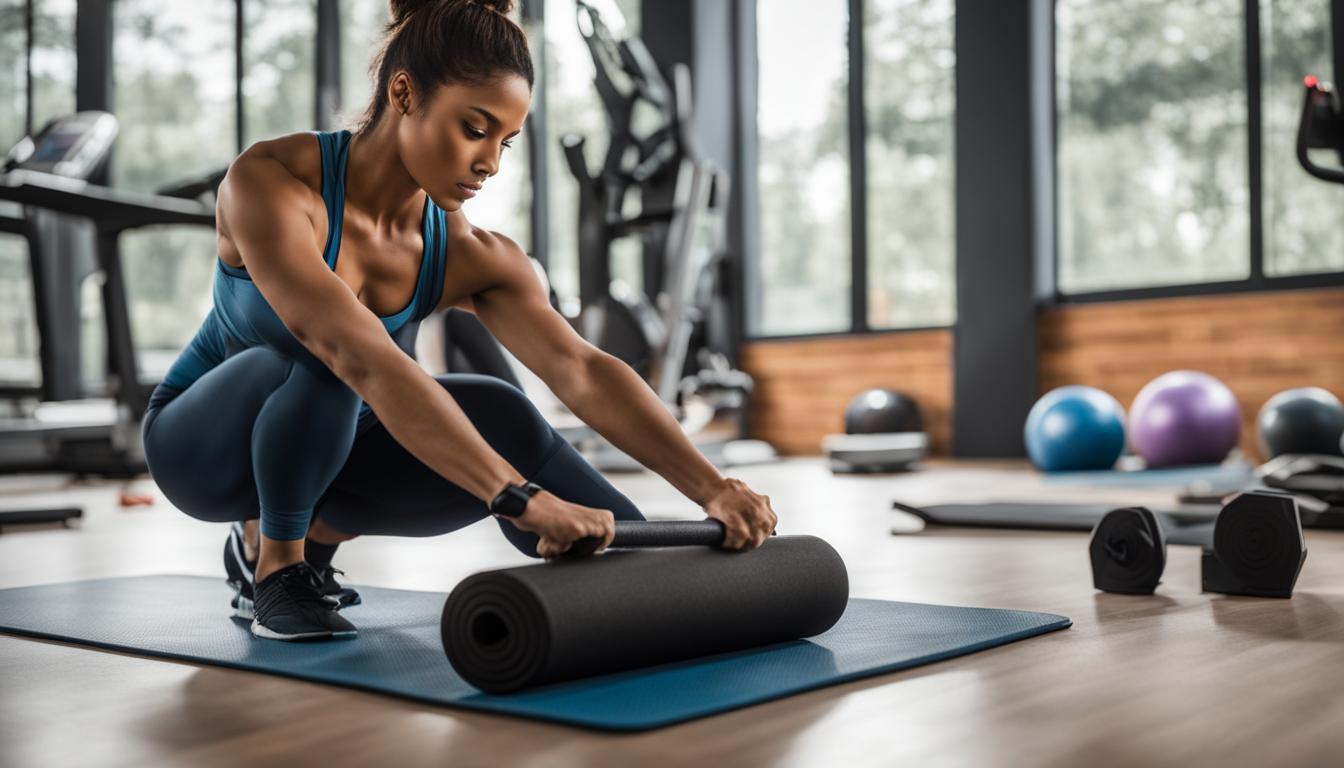Are you looking to improve your fitness and develop a well-rounded exercise regimen? Creating a balanced workout routine is the key to achieving your holistic fitness goals. By incorporating a variety of exercises and focusing on different aspects of fitness, you can ensure that your workouts are effective, enjoyable, and sustainable. Let’s explore how you can create a workout routine that supports your overall well-being.
When it comes to designing a balanced workout routine, it’s essential to consider the different components of fitness. This includes aerobic exercise, strength training, balance exercises, and incorporating variety. By including each of these elements in your workout plan, you can achieve optimal results and reduce the risk of injury. Let’s dive deeper into each aspect and learn how to structure your workouts for success.
Key Takeaways:
- A balanced workout routine combines aerobic exercise, strength training, and balance exercises.
- Follow the guidelines of the Physical Activity Guidelines for Americans, which recommend 150 minutes of moderate aerobic activity per week and strength training exercises for all major muscle groups.
- Incorporate balance exercises to improve stability, especially for older adults at risk for falls.
- Add variety to your workouts to prevent plateaus and keep yourself motivated.
- Start slowly, listen to your body, and gradually increase the intensity and duration of your workouts.
The Benefits of Aerobic Exercise in a Balanced Workout Routine
Aerobic exercise, such as walking, biking, running, and swimming, is a vital component of a balanced workout routine. It plays a key role in improving cardiovascular endurance and reducing the risk of various diseases. By engaging in regular aerobic exercise, you can strengthen your heart, boost lung capacity, and enhance overall fitness.
One of the major benefits of aerobic exercise is its positive impact on cardiovascular health. It increases your heart rate and breathing, promoting the efficient circulation of oxygenated blood throughout your body. This improved blood flow helps to strengthen your heart muscle, lowers blood pressure, and reduces the risk of heart disease, stroke, and other cardiovascular conditions.
In addition to its cardiovascular benefits, aerobic exercise also contributes to weight management and overall well-being. It aids in burning calories, which can assist in weight loss or maintenance. Engaging in aerobic activities regularly can also help improve mental health by reducing stress, boosting mood, and promoting better sleep.
The Importance of Cardiovascular Endurance
Cardiovascular endurance refers to the ability of your heart and lungs to supply oxygen-rich blood to your muscles during physical activity. By incorporating regular aerobic exercise into your workout routine, you can strengthen your cardiovascular system, enabling it to more efficiently deliver oxygen to your muscles.
“Cardiovascular endurance is essential for performing everyday tasks with ease and maintaining an active lifestyle,” says Dr. Jane Thompson, a certified fitness expert. “It enables your body to endure prolonged physical activity and enhances your overall stamina.”
To improve cardiovascular endurance, aim to engage in at least two and a half hours of moderate aerobic activity or one hour and 15 minutes of vigorous aerobic activity per week, as recommended by the Physical Activity Guidelines for Americans. Remember to start slow and gradually increase the intensity and duration of your aerobic workouts to avoid overexertion or injury.

Remember, incorporating aerobic exercise into your balanced workout routine can have a significant impact on your cardiovascular health, help manage weight, and enhance overall well-being. So lace up your shoes, hit the pavement, and get your heart pumping!
Strength Training for a Balanced Workout Routine
Strength training is a crucial component of a balanced workout routine. Not only does it help build lean muscle mass, but it also improves muscle strength and protects against bone loss. Incorporating strength training exercises into your fitness regimen can enhance your overall physical fitness and contribute to a well-rounded exercise program.
When engaging in strength training, it is important to target all major muscle groups. This includes exercises for the arms, shoulders, chest, back, abdomen, and legs. By working each muscle group, you can achieve a balanced physique and avoid muscle imbalances that may lead to injury.
Starting with lighter weights and gradually increasing the intensity is key in strength training. This allows your muscles to adapt and grow stronger over time. It is also important to maintain proper form and technique to prevent injuries. If you’re new to strength training, consider working with a personal trainer who can guide you through the exercises and ensure you’re using the correct form.
Incorporating strength training into your workout routine not only improves muscle tone and strength, but it also offers a range of benefits for overall health and well-being. From increased metabolism and improved bone density to enhanced posture and joint stability, strength training plays a vital role in achieving a balanced and healthy body.
The benefits of strength training
- Builds lean muscle mass
- Improves muscle strength and tone
- Increases metabolism and burns more calories at rest
- Enhances bone density and reduces the risk of osteoporosis
- Improves posture and joint stability
- Helps prevent injuries by strengthening muscles and connective tissues
“Strength training not only improves physical strength but also boosts confidence and empowers individuals to take control of their fitness journey.”
By incorporating strength training exercises into your balanced workout routine, you can achieve a well-rounded fitness plan that promotes overall health and vitality. Remember to start slowly, focus on proper technique, and gradually increase the intensity to maximize the benefits of strength training.
The Importance of Balance Exercises in a Balanced Workout Routine
When it comes to creating a well-rounded exercise regimen, balance exercises play a crucial role. These exercises are particularly important for older adults who may be at risk for falls. Poor balance can lead to injuries and negatively impact overall mobility and quality of life. Therefore, incorporating balance-enhancing activities into your workout routine is essential.
Balance exercises, such as tai chi, yoga, and Pilates, can help improve balance and coordination. These activities focus on strengthening the core muscles and enhancing stability. Additionally, exercises like the Paloff press, which target the core and challenge balance, can also contribute to better overall balance.
By regularly incorporating balance exercises into your workout routine, you can reduce the risk of falls and improve your overall physical stability. As you age, it becomes increasingly important to maintain a sense of balance, and these exercises are a proactive way to achieve that.

The Benefits of Balance Exercises:
- Improved balance and coordination
- Reduced risk of falls and related injuries
- Strengthened core muscles
- Enhanced overall stability and mobility
“Balance exercises are essential for older adults to maintain their independence and reduce the risk of falls. Incorporating activities like tai chi or yoga into your routine not only strengthens your core but also challenges your balance, helping you stay steady on your feet.”
Incorporating Balance Exercises:
When adding balance exercises to your workout routine, it’s crucial to start slowly and gradually increase the intensity and difficulty level. Pay attention to proper form and technique to maximize the benefits and reduce the risk of injury.
Try to include at least two to three balance-enhancing activities per week. You can join a class or follow online tutorials to ensure you’re performing the exercises correctly. Don’t be discouraged if you struggle at first—balance exercises are meant to challenge you, and improvement will come with time and practice.
Remember, a balanced workout routine should include a combination of aerobic exercise, strength training, and balance exercises. By incorporating these three components, you can achieve a well-rounded fitness plan and enhance your overall physical health and well-being.
The Role of Variety in a Balanced Workout Routine
When it comes to creating a balanced workout routine, variety is key. Incorporating different types of exercises and activities into your fitness program can help you avoid plateaus, keep your workouts interesting, and target different muscle groups. Cross-training is an effective way to add variety as it involves engaging in different forms of exercise, such as biking, swimming, and strength training, to work different parts of your body.
One popular form of cross-training is high-intensity interval training (HIIT), which alternates short bursts of intense activity with lower-intensity recovery periods. This type of workout not only adds variety to your routine but also helps improve cardiovascular fitness and burn calories. Additionally, incorporating flexibility exercises like yoga or Pilates can help enhance mobility and prevent muscle imbalances.
Adding variety to your workout routine not only challenges your body in different ways but also keeps you mentally engaged and motivated. It prevents you from getting bored with your workouts and encourages you to continue pursuing your fitness goals.
Benefits of Incorporating Variety:
- Avoids plateaus by constantly challenging your body
- Prevents overuse injuries by working different muscle groups
- Improves overall fitness and endurance
- Increases motivation by keeping workouts interesting
- Enhances flexibility and mobility
Remember, the key to a balanced workout routine is to strike a balance between consistency and variety. While it’s essential to have a routine, don’t be afraid to mix things up and try new activities. By incorporating cross-training, HIIT workouts, and flexibility exercises, you can ensure that your fitness program remains diverse, challenging, and enjoyable.
How to Structure Your Weekly Workout Plan for Optimal Results
Creating a well-structured weekly workout plan is essential for optimizing your results and reducing the risk of injury. By strategically diversifying your workouts and incorporating different types of exercises, you can target various muscle groups, enhance your overall fitness, and keep yourself motivated.
To design an effective weekly workout plan, it’s important to include strength training exercises for each major muscle group. Alternating upper body and lower body workouts can help prevent overtraining and allow for proper muscle recovery. Incorporating compound exercises that engage multiple muscle groups, such as squats, deadlifts, and push-ups, can provide a comprehensive strength-building workout.
Spacing out high-impact and low-impact activities throughout the week is also crucial. This helps to prevent excessive strain on specific muscles or joints and allows for adequate rest and recovery. For example, you can alternate days of cardio exercises like running or cycling with days of low-impact activities like yoga or swimming.
The Benefits of Diversifying Your Workouts
- Diversifying your workouts helps prevent plateauing and keeps your workouts interesting and engaging.
- By engaging in different types of exercises, you target different muscle groups and improve overall strength and flexibility.
- Integrating different workout modalities, such as HIIT, endurance training, and flexibility exercises, can enhance your overall fitness level.
- Changing up your workouts also challenges your body and mind, preventing monotony and boosting motivation.
Incorporating variety through HIIT-style workouts is another effective way to diversify your routine. HIIT involves short bursts of intense activity followed by brief recovery periods. This type of training not only helps improve cardiovascular endurance but also increases calorie burn and stimulates muscle growth.
Remember, finding activities you enjoy and listening to your body are key to sustaining a balanced workout routine. By following a well-structured weekly plan, you can optimize your fitness journey and achieve long-term success.

Tips for Getting Started with a Fitness Program
Starting a fitness program is an exciting journey towards improved health and well-being. Whether you’re a beginner or getting back into fitness after a break, it’s important to approach your new routine with careful planning and consideration. Here are some tips to help you get started and set yourself up for success:
Assess Your Fitness Level
Before diving into any fitness program, it’s essential to assess your current fitness level. This will help you establish a baseline and set realistic goals for progress. Take measurements such as pulse rate, walking or running times, and flexibility. Consider consulting with a healthcare professional or fitness expert to get a more comprehensive assessment.
Design a Fitness Program
Once you have a clear understanding of your fitness level, you can design a personalized fitness program that suits your goals and abilities. Set specific, achievable objectives and create a well-rounded routine that includes both aerobic and strength training exercises. Gradually increase the intensity and duration of your workouts as your fitness improves.
- Incorporate aerobic exercises like walking, jogging, or cycling to improve cardiovascular endurance.
- Include strength training exercises to build muscle strength and tone.
- Integrate flexibility exercises like stretching or yoga to improve mobility and prevent injury.
Remember to start slowly and gradually build up your workout intensity. Listen to your body and make adjustments as needed to avoid overexertion or injury. Consistency is key, so aim to make your fitness program a regular part of your lifestyle.
By following these tips, you’ll be well on your way towards starting a fitness program that is tailored to your needs and goals. Remember to consult with a healthcare professional or fitness expert if you have any specific concerns or medical conditions. Enjoy the process and have fun as you embark on your fitness journey!
Assembling the Right Equipment for Your Balanced Workout Routine
To create a successful and well-rounded workout routine, it’s important to have the right equipment. The right fitness equipment can enhance your exercise experience, improve performance, and help you stay motivated. Here are some key items to consider:
1. Athletic Shoes
Investing in a pair of high-quality athletic shoes that are suitable for your chosen activities is essential. The right shoes provide support, stability, and cushioning, helping to prevent injuries and maximize comfort. Whether you’re into running, weightlifting, or group fitness classes, make sure to choose shoes that are designed for the specific demands of your workouts.
2. Fitness Apps and Activity Tracking Devices
Technology has made tracking your fitness progress easier than ever. Fitness apps and activity tracking devices allow you to monitor your steps, distance, calories burned, and even heart rate. These tools can help you set goals, stay accountable, and track your progress over time. Whether you prefer a dedicated fitness tracker or use your smartphone, find an app or device that suits your needs and keeps you motivated.
3. Exercise Equipment
Depending on your preferences and space availability, you may want to invest in exercise equipment for your home workouts. This can include items such as dumbbells, resistance bands, yoga mats, stability balls, or even cardio machines like treadmills or stationary bikes. Consider your fitness goals, interests, and budget when selecting the right exercise equipment to complement your routine.
In addition to the specific equipment mentioned above, don’t forget the basics: comfortable workout clothes, a water bottle for hydration, and a towel for sweat. Having all the necessary equipment will help you create a convenient and enjoyable workout environment, making it easier to stick to your balanced fitness program.

Remember, it’s not just about the equipment itself, but how you use it in conjunction with a well-designed workout routine. Prioritize safety, proper form, and gradual progression as you incorporate new equipment into your fitness program. With the right equipment and dedication to your balanced workout routine, you’ll be well on your way to achieving your fitness goals.
Getting Started with Your Balanced Workout Routine
Now that you have your balanced workout routine planned and all the necessary equipment, it’s time to get started on your fitness journey. Remember, it’s important to start slowly and build up gradually to avoid injuries and allow your body to adapt to the new physical demands.
Begin each workout with a warm-up to prepare your muscles and joints for exercise. This can be a few minutes of light cardio, such as brisk walking or cycling. After your warm-up, gradually increase the intensity and duration of your workouts over time. This gradual progression is key to preventing overexertion and ensuring long-term success.
Flexibility is also an essential component of a balanced workout routine. Incorporate stretching exercises at the end of each workout to improve flexibility and prevent muscle tightness. Dynamic stretches, such as leg swings or arm circles, can be done before your workout to further enhance flexibility.
Quick Tips:
- Listen to your body and take rest days when needed. Recovery is just as important as exercise.
- Break up your exercise sessions throughout the day if you have time constraints. For example, you can do a short workout in the morning and another in the evening.
- Find activities you enjoy to make your workouts more enjoyable and sustainable. Whether it’s dancing, hiking, or playing a sport, variety keeps your routine interesting and helps you stay motivated.
Remember, the key to long-term success is consistency and patience. Building a balanced workout routine takes time, so don’t get discouraged if you don’t see immediate results. Focus on making exercise a habit and gradually increasing the intensity and duration of your workouts. With determination and perseverance, you can achieve your fitness goals and reap the many benefits of a well-rounded exercise regimen.
Conclusion
Creating a balanced workout routine is key to achieving long-term exercise success. By following the guidelines for a well-rounded fitness program, you can improve your overall health and fitness levels. Remember to monitor your progress regularly to stay motivated and make necessary adjustments to your goals.
Monitoring your progress is crucial in maintaining your exercise routine. Keep track of important measurements, such as pulse rate, walking or running times, and flexibility, to see the improvements over time. This will provide you with the satisfaction of knowing that your hard work is paying off.
As you embark on your fitness journey, it’s important to remain flexible. Listen to your body’s needs and be open to modifying your routine if necessary. Enjoy the process and find activities that bring you joy, as this will increase your chances of sticking to your balanced workout routine for the long haul.
FAQ
How much aerobic exercise should I include in my balanced workout routine?
The Physical Activity Guidelines for Americans recommend 150 minutes of moderate aerobic exercise or 75 minutes of vigorous aerobic activity per week.
How often should I do strength training in my balanced workout routine?
The guidelines recommend strength training exercises for all major muscle groups at least two times a week.
Why are balance exercises important in a balanced workout routine?
Balance exercises are particularly important for older adults at risk for falls. They can help improve balance and coordination.
How can I add variety to my workout routine?
Cross-training with different activities and incorporating high-intensity interval training (HIIT) are effective ways to add variety to your workout routine.
How should I structure my weekly workout plan for optimal results?
It’s recommended to include strength training exercises for each major muscle group and alternate upper and lower body workouts.
How do I get started with a fitness program?
It’s important to assess your fitness levels, set clear goals, and gradually increase intensity.
What equipment do I need for a balanced workout routine?
It’s important to choose appropriate athletic shoes and consider investing in practical and enjoyable exercise equipment.
How do I start my balanced workout routine?
Start slowly, build up gradually, and listen to your body’s needs. Warm up and cool down with gentle stretching or walking.
How can I ensure long-term exercise success?
By following the guidelines for a balanced fitness program, monitoring progress, and adjusting goals as needed, you can establish a healthy habit that lasts a lifetime.


